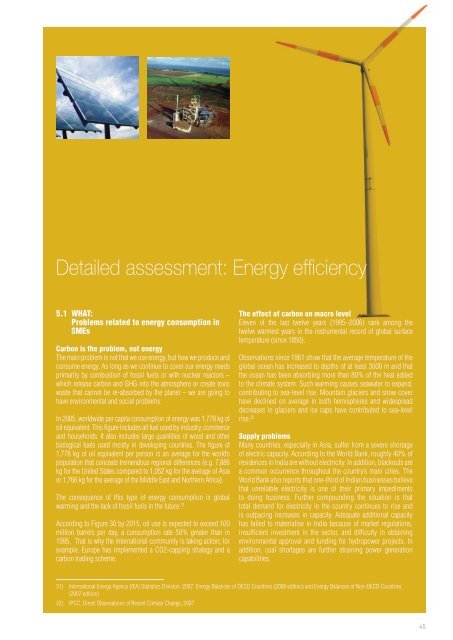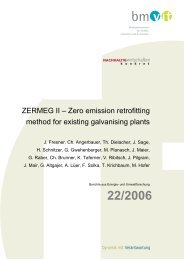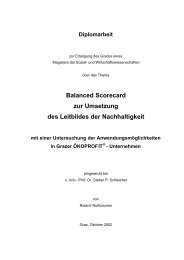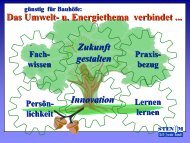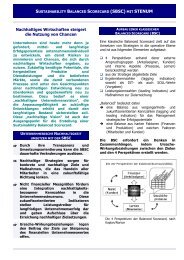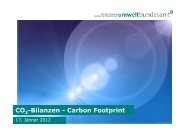Promoting Resource Efficiency in Small & Medium size ... - UNEP
Promoting Resource Efficiency in Small & Medium size ... - UNEP
Promoting Resource Efficiency in Small & Medium size ... - UNEP
You also want an ePaper? Increase the reach of your titles
YUMPU automatically turns print PDFs into web optimized ePapers that Google loves.
Detailed assessment: Energy efficiency<br />
5.1 WHAT:<br />
Problems related to energy consumption <strong>in</strong><br />
SMEs<br />
Carbon is the problem, not energy<br />
The ma<strong>in</strong> problem is not that we use energy, but how we produce and<br />
consume energy. As long as we cont<strong>in</strong>ue to cover our energy needs<br />
primarily by combustion of fossil fuels or with nuclear reactors –<br />
which release carbon and GHG <strong>in</strong>to the atmosphere or create toxic<br />
waste that cannot be re-absorbed by the planet – we are go<strong>in</strong>g to<br />
have environmental and social problems.<br />
In 2005, worldwide per capita consumption of energy was 1,778 kg of<br />
oil equivalent. This figure <strong>in</strong>cludes all fuel used by <strong>in</strong>dustry, commerce<br />
and households. It also <strong>in</strong>cludes large quantities of wood and other<br />
biological fuels used mostly <strong>in</strong> develop<strong>in</strong>g countries. The figure of<br />
1,778 kg of oil equivalent per person is an average for the world’s<br />
population that conceals tremendous regional differences (e.g. 7,886<br />
kg for the United States compared to 1,052 kg for the average of Asia<br />
or 1,766 kg for the average of the Middle East and Northern Africa).<br />
The consequence of this type of energy consumption is global<br />
warm<strong>in</strong>g and the lack of fossil fuels <strong>in</strong> the future. 31<br />
Accord<strong>in</strong>g to Figure 30 by 2015, oil use is expected to exceed 100<br />
million barrels per day, a consumption rate 50% greater than <strong>in</strong><br />
1995. That is why the <strong>in</strong>ternational community is tak<strong>in</strong>g action; for<br />
example, Europe has implemented a CO2-capp<strong>in</strong>g strategy and a<br />
carbon trad<strong>in</strong>g scheme.<br />
The effect of carbon on macro level<br />
Eleven of the last twelve years (1995–2006) rank among the<br />
twelve warmest years <strong>in</strong> the <strong>in</strong>strumental record of global surface<br />
temperature (s<strong>in</strong>ce 1850).<br />
Observations s<strong>in</strong>ce 1961 show that the average temperature of the<br />
global ocean has <strong>in</strong>creased to depths of at least 3000 m and that<br />
the ocean has been absorb<strong>in</strong>g more than 80% of the heat added<br />
to the climate system. Such warm<strong>in</strong>g causes seawater to expand,<br />
contribut<strong>in</strong>g to sea-level rise. Mounta<strong>in</strong> glaciers and snow cover<br />
have decl<strong>in</strong>ed on average <strong>in</strong> both hemispheres and widespread<br />
decreases <strong>in</strong> glaciers and ice caps have contributed to sea-level<br />
rise. 32<br />
Supply problems<br />
Many countries, especially <strong>in</strong> Asia, suffer from a severe shortage<br />
of electric capacity. Accord<strong>in</strong>g to the World Bank, roughly 40% of<br />
residences <strong>in</strong> India are without electricity. In addition, blackouts are<br />
a common occurrence throughout the country’s ma<strong>in</strong> cities. The<br />
World Bank also reports that one-third of Indian bus<strong>in</strong>esses believe<br />
that unreliable electricity is one of their primary impediments<br />
to do<strong>in</strong>g bus<strong>in</strong>ess. Further compound<strong>in</strong>g the situation is that<br />
total demand for electricity <strong>in</strong> the country cont<strong>in</strong>ues to rise and<br />
is outpac<strong>in</strong>g <strong>in</strong>creases <strong>in</strong> capacity. Adequate additional capacity<br />
has failed to materialise <strong>in</strong> India because of market regulations,<br />
<strong>in</strong>sufficient <strong>in</strong>vestment <strong>in</strong> the sector, and difficulty <strong>in</strong> obta<strong>in</strong><strong>in</strong>g<br />
environmental approval and fund<strong>in</strong>g for hydropower projects. In<br />
addition, coal shortages are further stra<strong>in</strong><strong>in</strong>g power generation<br />
capabilities.<br />
31) International Energy Agency (IEA) Statistics Division. 2007. Energy Balances of OECD Countries (2008 edition) and Energy Balances of Non-OECD Countries<br />
(2007 edition)<br />
32) IPCC, Direct Observations of Recent Climate Change, 2007<br />
45


